Agra - The Mughal Capital
A weekend getaway to Agra - the city of marvelous Taj Mahal and Fatehpur Sikri.
TRAVEL
Twinkle Suri
3/1/202414 min read

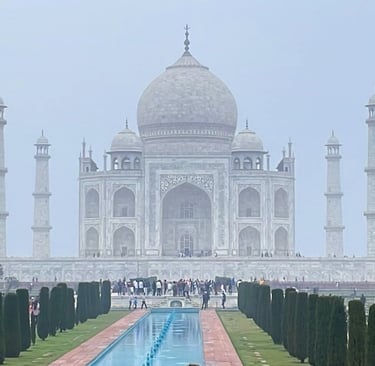
I don’t know if it is the right thing to give this blog such a caption, but since I was told by the historians that it was indeed the capital during the rule of the Mughal king Akbar for a brief period of time, I’d stick with this one!
This was a rather short trip to Agra, for we had gone there for the weekend, but I guess I am capable of summing up all the right things about the city, here in this another travel blog of mine. Agra is known for, and is worldly famous for Taj, “The Taj” as people precisely would like to call it, the “The” emphasizing not just the sheer importance it holds for a country such as India (being a part of the seven wonders of the world), but also in my opinion to the humongous size it has. It has to be a “The”, a special entity. The city is known for Taj, a part of the Mughal empire’s beautiful history chapter, but the city is much more than that. It is beautifully connected to Delhi via the national highway, Yamuna Expressway, which makes the entire journey thoroughly smooth and easy. The city is developing its own metro network, which is an additional point for the future travelers. It is a city which is like most of the North Indian cities in the country, has its own parts of the town, some being rich and highly developed to some being crunched up in spaces where you can find everything, from tea stalls to small restaurants to electronics and dairy shops. Yes, it was interesting to observe a lot of dairy shops here, selling fresh milk and milk products which are mostly made, I’d guess, from buffalo milk. The city is famous for its sweet ‘Petha’ - which is actually ash gourd or white pumpkin dried and then dunked and kept in heavy sugar syrup until it changes its texture to a soft assortment, almost like a Turkish delight, but with a bite. You can find it in different flavors in this city and with different inner fillings, and almost every second shop selling it. Another one of the famous foods of this city is ‘Dalmoth’, which is a namkeen mixture made of fried lentils, besan (chickpea flour) sev, nuts and some spices and sometimes little pieces of fried potatoes. This is eaten usually with bread and butter as a part of the breakfast, but can be eaten as a snack with tea. The history owes it to being 200 years old and an Uttar Pradesh staple, but it is when you visit Agra that you realize how it is rooted in the culture. Talking about breakfast, the people in Agra, like any other city in the Uttar Pradesh, are fond of eating puris and kachoris for breakfast along with aloo (potato) bhaji. While puris are fried kneaded whole wheat flour (atta) small chapatis, kachoris are made with refined wheat flour (kneaded and rounded), fried and usually filled with either potato-onion spicy filling or spiced dry lentil (dal) filling. The aloo (potato) bhaji is a heavily spiced curry made of onion, tomatoes, ginger, potatoes and sometimes black chickpeas or peas (in some parts of Uttar Pradesh) along with green chilies. This assortment combination you can find in Agra almost everywhere, from the smallest of the stalls to the larger restaurants and even hotel buffets. A version of this dish, especially known to Agra is ‘Bedai’ - the spicy potato curry with filled puris/ kachoris and a helping of yoghurt. Other common foods available in the most North Indian states are also available easily here, ranging from parathas to pakoras to chana bhatura. Another interesting thing that I found in the city while I was exploring some food options on the food delivery app Zomato, was that people are fond of ordering and eating this one particular North Indian curry - ‘Matar Aloo’, which is a staple dish made at home, in the places where I grew up and spent my childhood; a spiced curry made with onions, tomatoes, ginger, garlic (optional), potatoes and peas. And last but not the least, the city has amazing list of national and international hotel chains, so it is easy to find and stay in a comfortable spot in this city, with good food. And yes, there are food chain restaurants like McDonalds and Domino’s catering to your cravings now and then, readily.
Coming to the important part of the city, what I feel is that the history of the city is rich, much more than the sheer size (yes, I’ll talk about it often) of the Taj Mahal could encompass. We went first to see the Taj which is situated in the older part of the city, densely crowded around with small eateries and shops. The whole area is huge and empty though, once you enter the premises. The entrance to the main monument is better via the Western gate which is less crowded on regular days and after the initial entry, there is another entrance darwaza (gateway) decorated the same way with Pashto and Urdu carvings of ‘aayatein’ (writings/poems/prose’) as most of the other Mughal gates of that time, easily found in New Delhi as well.
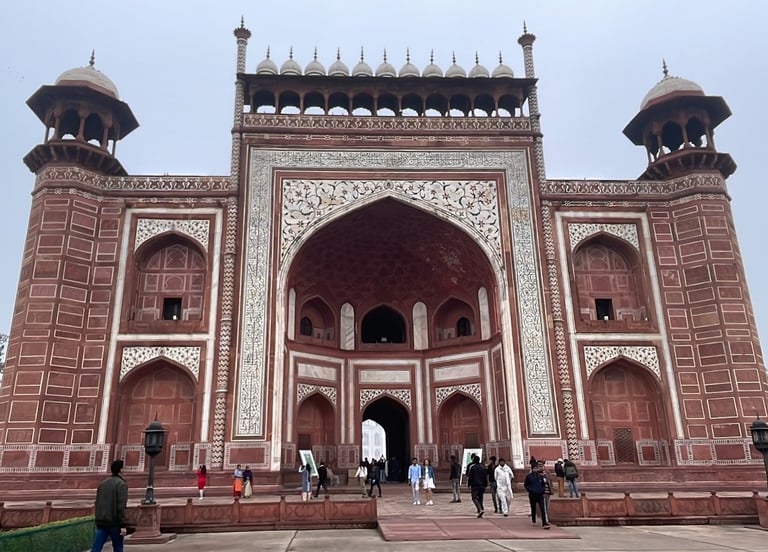

The courtyard is huge and one can see beautiful architecture of and on red stone at this point. The entrance opens up to the view of Taj, huge like anything I’ve ever seen in my life (yeah, not those buildings of Delhi and Mumbai, it’s something!). One can see the Taj, white and shining from a distance here, just standing. As you traverse towards the monument, passing through the Char Bagh, the center point of the quadrilateral, passing through beautiful and lush green gardens and fountains running, which is known as the Mughal Garden, there are several points to take pictures here and crowds are lined up to take some with the beautiful background; but oh, damn I was amazed by the growing size of the monument! It is huge (yes, I said it again), the marble that has been used to make it is now tainted but it is still white and to do something like that, to think of making something like that and to execute it, even if you’re a king, isn’t a small piece of affair.
The history calls it a mausoleum and associates it to Mughal ruler Shah Jahan, who got it built in 1643 for his wife Mumtaz Mahal. It was completed entirely in 10 years and in the center part of the monument, where one has to buy extra charged tickets to explore, lies the false tomb of him and his wife both. The actual tombs are at the lower level, never open to the public. It has also been declared as a UNESCO world heritage site and measures are taken, as one can notice, to keep the monument intact and preserved for as long as possible. There is Arabic calligraphy on the walls here as well and that adds up to the beauty of this beautiful monument. Considered as one of the finest monuments and epitome of Mughal art history in the country, it is indeed a very beautiful site to see. I was amazed, yet again, by not just the architecture and the decorations but the sheer size of it. There’s a mosque nearby the main courtyard on one side, which is fully functional and is the reason why the monument is closed for public and tourists on Friday; and on the other side is a museum displaying some artefacts related to Shah Jahan, Mumtaz Mahal and the depiction of The Taj over the years, in form of drawings and sketches by various artists. And yes, the Yamuna river flows in the background, on the back side of the Taj and is a pretty site to see, subtracting the garbage it carries coming from the city of Delhi and various places in between. I washed it was cleaner because it accentuates the whole experience and is again, huge and beautifully free flowing. On one side closer to the exit, it is easy to find the display panel of historical and prominent places in the country, and one can (as was there in our case) observe and note down the places yet to visit, the places that can be visited in the country, if like me you are a fan of culture, art and architecture culminated with history and aesthetics.
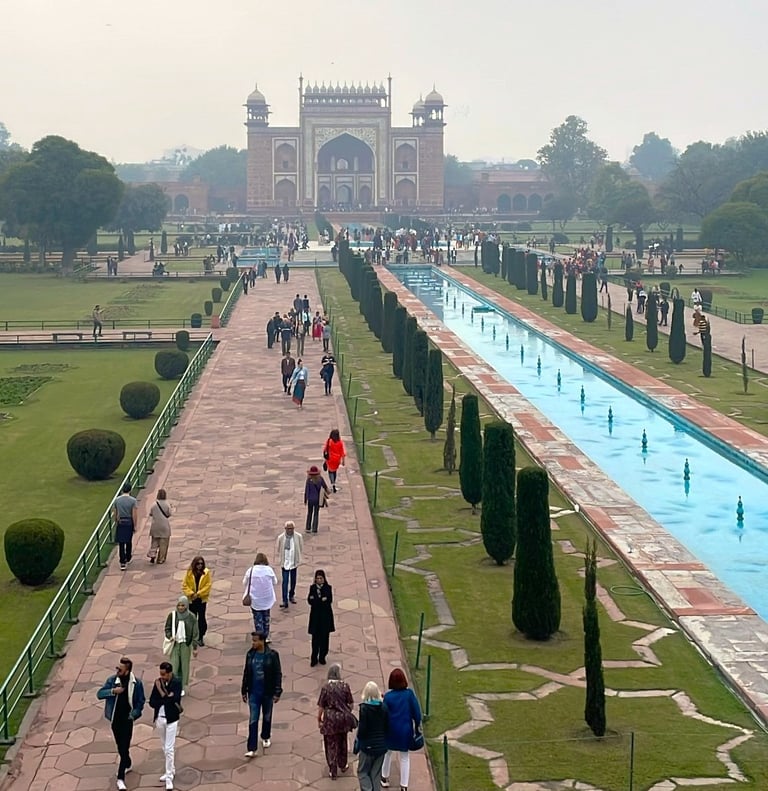

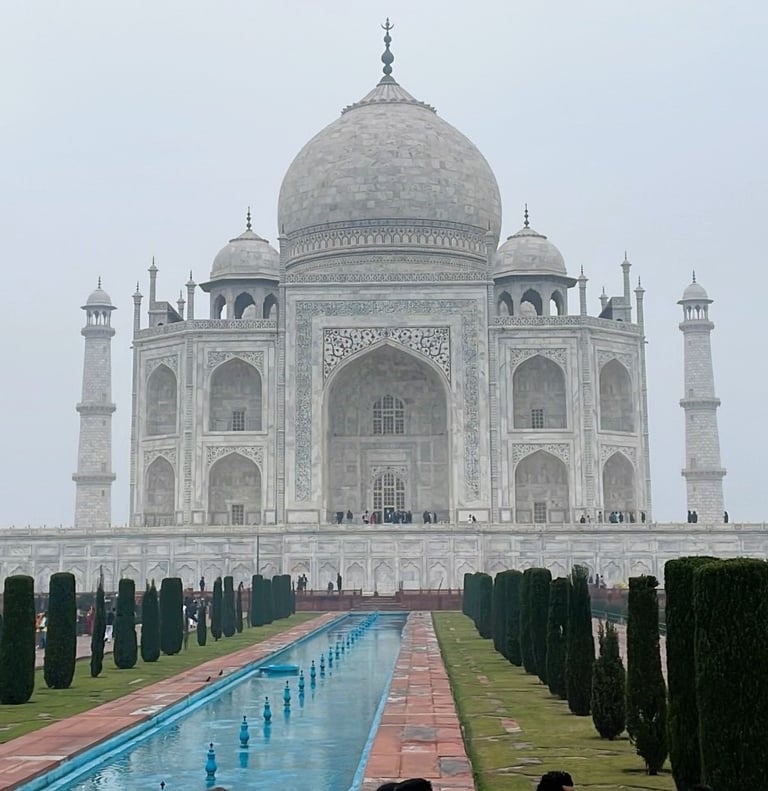

Taj is considered as a symbol of love, being made for a wife from a husband. I cannot say I felt the same way about the monument very honestly, though I can tell effort was put to make a mark and prove a point. I personally think love is best shown when both the people are alive, to each other, and should be felt by people around them as well and history doesn’t tell any stories about their love when both of them were alive. Yet again, it is my personal observation and I’d much prefer to call this monument a symbol of beautiful architecture and an important historical landmark in the centuries that preceded us.
The next day we visited another landmark in the history of Mughal empire in the India. Fatehpur Sikri - once the capital of India under the rule of Akbar from 1571 to 1585, before he shifted it to Agra and then to Delhi. It is 43kms from Agra and easily accessible by road. One has to park the vehicle at the designated place and go to the main site via a mini bus, along with other tourists, the only way to reach the main location. Archaeological Survey of India has made it an important research site and designated and trained guides are available here, by the same organization for better understanding and visit of the whole place. Now call me biased but the history here is much richer, poised and in a way, slightly more positive and interesting. It is said that Akbar had main three wives, all belonging from different religions - Muslim, Hindu and Christian but none of them was able to give him a child. Since the rule was to be given to the future king after his father died, Akbar was looking for a way to bear a legitimate son, having visited several temples and mosques for blessings. It was when he visited the famous mosque of Hazrat Salim Chisti (his burial place) and begged for a child, his Hindu wife was able to bear a child, ‘Salim’, named after the main person of the Dargah (mosque) itself. He was so elated from this development that he declared the town as his capital and built the whole complex where he and his family along with the servants would stay, where he would rule as a king. Fatehpur Sikri was that town and as you enter the main complex from Agra, you are welcomed by the Agra Darwaza from the backside, and the first thing that will catch your eye are the ruins of the then established capital, red stone and all, on a rocky terrain, that in my opinion adds a beautiful start to the things to see ahead. When I saw them I recalled a very beautiful film that left an impression on my mind that I saw a few years ago, “Bergman Island”; the place and ruins where Bergman, a famous Swedish director, shot a couple of his films and spent some time (as discussed and shown in detail in the film) looked the same, almost the same as the ruins that were in front of me (and don’t worry, if you’ve not watched the film or heard of the director, I’ll talk about him in a couple of suggestions and blogs in the “Art” category).
Anyways, going back to the scene in the present, the complex where Akbar ruled is divided in two parts, the main capital of Fatehpur (‘Fateh’ meaning victory) and the famous Buland Darwaza (high gate), the largest known ‘gate’ in the county till date. The capital complex of Fatehpur is further divided into certain sections. The first one is the ‘Diwan-e-aam’ (‘aam’ meaning common) which is a sitting complex with a raised pavilion having huge lush green gardens in the front (which were cemented during the king’s time) where the king used to listen to the common public, address them and solve their issues and grievances. From here one walks to the ‘Diwan-e-khaas’ (‘khans’ meaning special), which was used by the king to address and have meetings with his special court and his ministers. About the inside area is a huge complex with beautiful architecture and a pillar in the center of the court (if it can be called that) which is elevated to about 10 feet and the king used to sit on the top and address the court. The pillar below has carvings depicting Muslim, Hindu and Cristian traditional architecture suggesting that all religions were equal for the king. Interestingly, Akbar, from this very court started another religion in his reign called ‘Din-I-ilahi’ meaning “God’s religion” to remove cast and religious differences and to bind people in his rule, but due to the people sticking to their own religious beliefs and it not being followed and progressed by the successors of the king, this became lost somewhere in the Mughal Empire, majorly known for establishing and propagating Muslim religion.
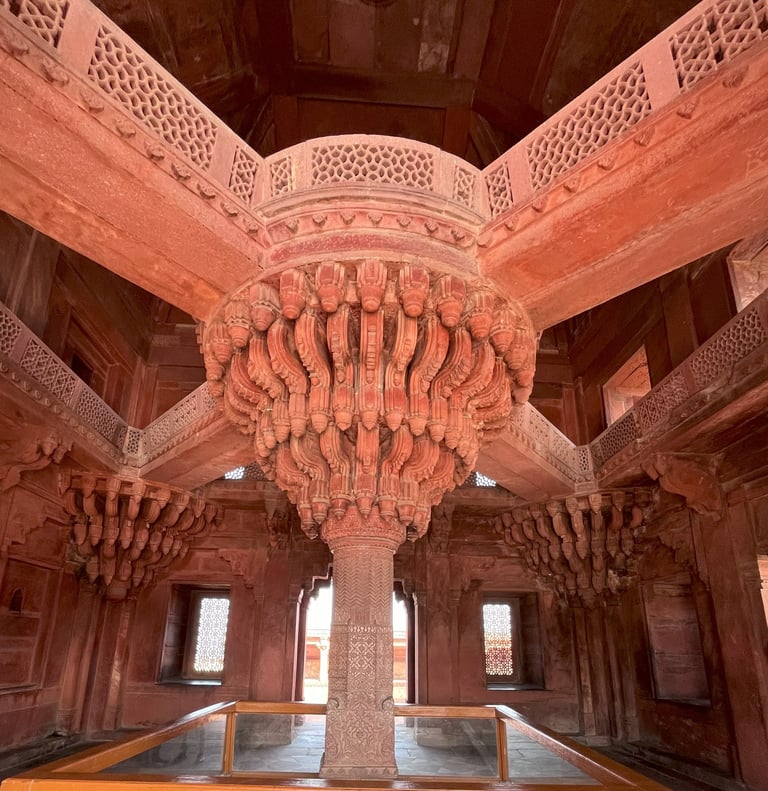

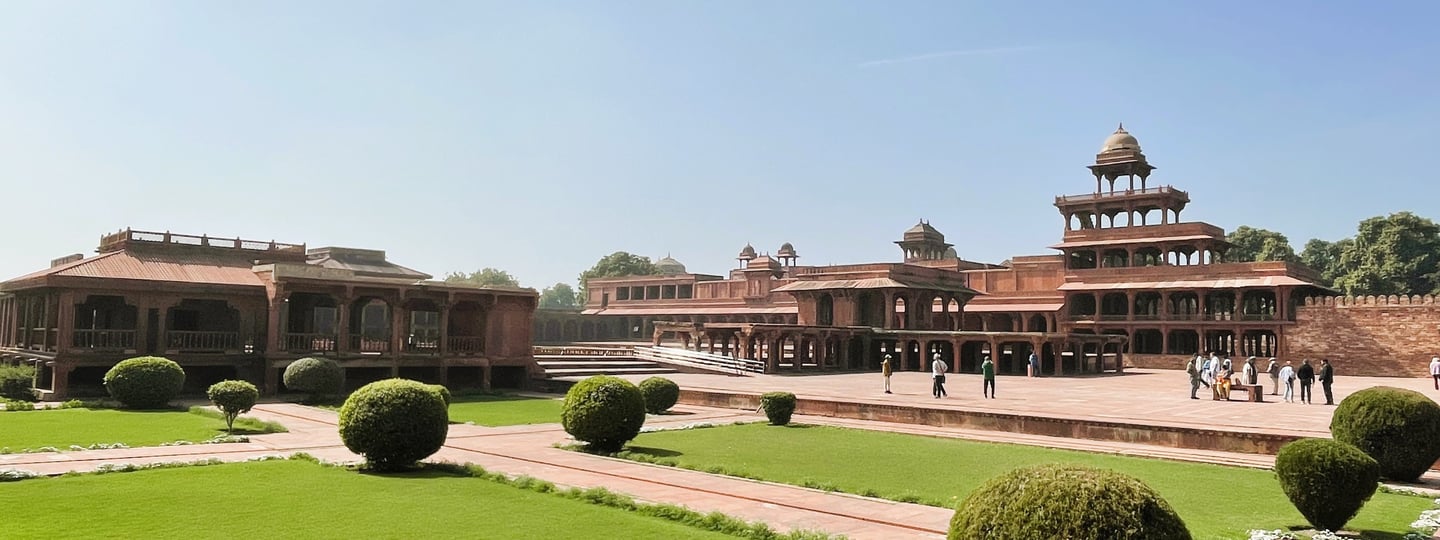

The courtyard following the ‘Diwan-e-khaas’, the Courtyard of Daulat Khana, has a couple of other things that depict the forwardness of the king Akbar as well his ways of ruling, which are usually described as different than the kings that preceded and followed him. In the courtyard is some area dedicated to the game of Chausar, one of the most ancient games in India, made for the king’s amusement. The king would sit in the center and would play the game of dice rolling along with his queens and servants. There is the beautiful Panch Mahal on one side which is five levelled and at the lowest level is the open area surrounded by just pillars, which is believed was used as a place to teach girls.
On the extension of this building is a place whose third, fourth and fifth floors are open as well for the king to sit and spend time with his wives in summer. Moving ahead one starts to see different small palace complexes built by the king for his different wives. The first wife, who was Muslim and belonged from Turkey, lived in a red sandstone carved room (more like a huge rest place) called Sultana’s Apartment, decorated with Turkish and Persian carvings throughout the inside and the outside of the room. It is said that the inside of her room was decorated with diamonds and gold, extracted and taken away during the British Raj in India. It is intricately detailed and gives a feeling of being royal, indeed.
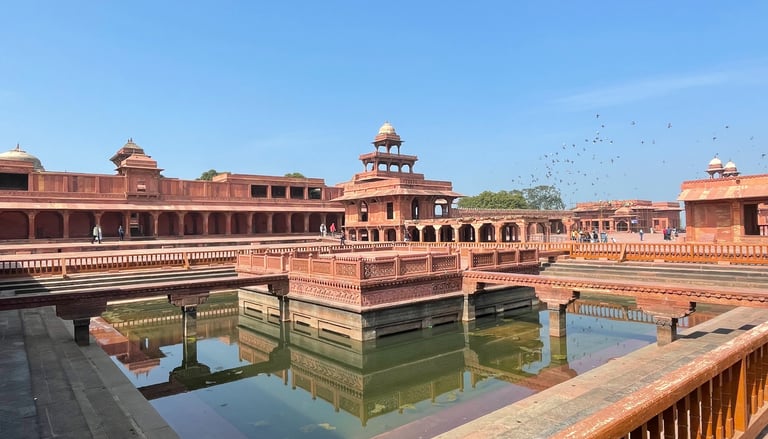

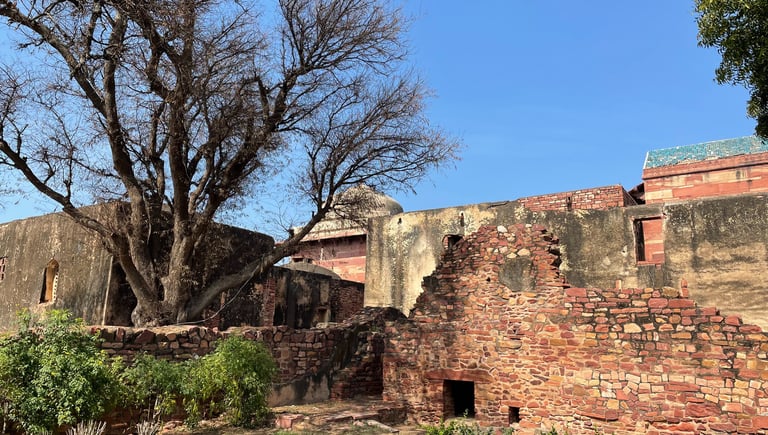

The complex which it surrounds encompasses a small water body in the center, called Anoop Talab, providing a freshness to the whole place. In the center lies the Tansen Chabutra, where one of the considered gems of Akbar’s time, singer Tansen used to sit and sing. On the left side of this is the entrance to the fort area, where one can see a huge vessel kept on the outside in the direction of the flowing wind; it was said that this vessel was filled with perfume up to the brim and would sprinkle the air inside the palace with freshness and perfumery as the winds blew, what smartness indeed! Following this is the dining place of the king with separate sections for vegetarian and non-vegetarian dishes, and his royal bedroom which was elevated, following the direction of the winds and water bodies nearby to maintain the temperatures and coolness in hot weathers. Following the pathway one can see Queen Jodha’s separate kitchen (because she was a Hindu and a Rajputana princess having only vegetarian meals) and connects to the Panchayat Mahal in the end. Through the way one can reach the inside complex, more intricately built and more thoroughly designed, the first thing to see is the room of the other wife of Akbar who was Christian, called ‘Mariam House’. There is a church like building in the complex nearby believed to be made for her. This is followed by the largest complex in the place, Jodhabai’s palace. Made with intricate Rajasthani/ Rajputana architecture and style and having ‘jharokas’, the windows that one can see easily in palaces and forts in Rajasthan, this palace has a huge complex area with a center point dedicated to plant the holy ‘Tulsi’ - a plant prayed by Hindus and having side walls showing and built with Hindu carvings and complex Rajasthani architecture during that time. Behind this palace area is the Birbal’s palace, which was built for the king’s most admired minister till date due to his sharp wit and wisdom, Birbal. The palace here has the most thorough architecture that I saw in the whole duration and says something about the king and his kin, in a different way. The last part, the king’s stables, where the king’s horses were kept along with the servant quarters of the time, where bathing and toilet facilities were present.
After coming outside of this huge complex, is yet another complex (the other part) which ends in Buland Darwaza (gate). The entrance to the complex before that calls for removal of shoes, to respect the dead buried there and it belong a holy complex. The gate was especially built to commemorate the king’s victory over Gujarat in 1573, and faces Gujarat state, and was later used by common masses to enter the Jama Masjid and the Dargah which answered the prayers of the king and gave him a son. The entry for the king, was via a different gate, called the ‘King’s Gate’ and you can move in the complex to see the tombs of various people in the courtyard, followed by the Anar Kali tunnel which is closed now. The tunnel is believed to have led to Anarkali’s grave I’d say, where Anarkali, a courtyard dancer who fell in love with Akbar’s son was brick walled alive in the walls for people to remember the consequences for such ‘crime’ at that time. Following is the tomb of Hazrat Salim Chisti, made in white marble, where one can offer their prayers and seek blessings. This is followed by the huge Jama Masjid, a mosque. You can end the trip at Buland Darwaza, at the opposite side of the Dargah, and see the town’s view from there. It has exemplary Mughal architecture and is 54 meters tall from the ground level having inscriptions from Quran and Islamic verses written in Persian. From here you can go back to the main entrance, where the cars are parked via the same mini bus. It, by the way, not just has the parking facility but also small restaurants for refreshments and some shops for souvenirs.

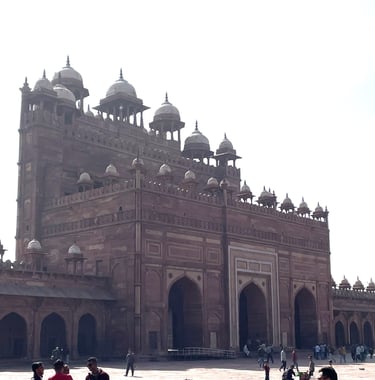

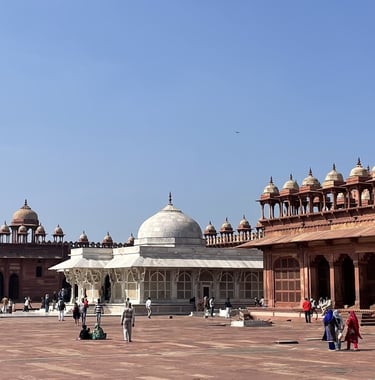
Heading back to the city of Agra, I felt like how much the history can tell, how much the world can understand and how much of it was real or not real, to be honest, is a difficult thing to tell. There is another fort to visit, The Agra Fort, which is near the Taj Mahal, but due to crunched up time, we skipped on that.
It has been long since I’ve been exploring, seeing and trying to comprehend something out of all these monuments and places that I visited in this country. The culture is rich, the atmosphere and architecture are dynamic and intriguing, everyone says this and everyone who’s visited this country and its cities knows. But what fascinates me the most is the way things are perceived and responded to in this country, even in the present of our past in front of us. Being an Indian, it is easy for me to know the thoughts most of us have before we go and visit such places and how we try to negate them even after visiting them just because of our intricate values and ideas and perceptions given to us since birth, the conveniences we accepted to keep with us as a part of who we are. It is seldom possible for an Indian to visit these places, see them and feel nothing. Yes, it is related to us and is our history so we cannot ignore it, but the more I visit the places in the country, I am happy to be just able to see things, explore them and not get ideas, challenge my ideas or beliefs or get offended by anything, just enjoy the travelling with an open mind, in my opinion, thus far is the only way to travel.


